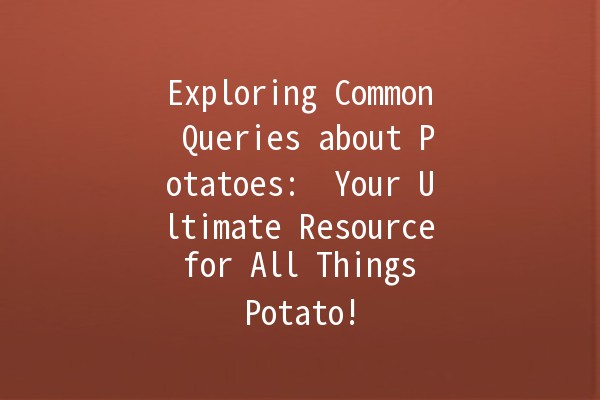Potatoes are often regarded as the “starch of life” due to their versatility and plethora of uses in cuisines worldwide. However, along with their nutritional value and culinary applications, there are many questions that people frequently ask about potatoes. This article delves deep into some of the most common queries regarding potatoes, providing valuable insights and tips to enhance your potatorelated culinary experiences.
What Makes Potatoes So Popular?
Nutritional Value

Potatoes are rich in carbohydrates, especially starch, making them a great source of energy. They also contain essential vitamins and minerals such as vitamin C, vitamin B6, potassium, and dietary fiber. This combination of nutrients contributes to their popularity as a staple food in many cultures.
Culinary Versatility
From mashed potatoes to fries, potato chips to jackets, and potato salads to soups, the versatility of potatoes knows no bounds. Their ability to absorb flavors and complement a wide array of ingredients further elevates their status in the culinary world.
Economic Factors
Potatoes are relatively inexpensive and widely available, making them an accessible food source for many families. They can be stored for extended periods without losing quality, which is another contributing factor to their popularity.
Five Tips to Enhance Your Potato Cooking Skills
Different varieties of potatoes yield different results in cooking. Here’s a quick breakdown:
Russet Potatoes: Best for baking and frying due to their higher starch content.
Yukon Gold Potatoes: Great for boiling and mashing because of their creamy texture.
Red Potatoes: Ideal for salads and soups as they maintain their shape well when cooked.
Tip: Always select firm potatoes free from blemishes or sprouts for the best quality.
For luscious, creamy mashed potatoes, follow these simple steps:
Boil peeled potatoes until tender.
Drain and return to the pot to evaporate excess moisture.
Add butter and warm milk, then mash with a potato masher or ricer for an ultrasmooth texture.
Example: Adding roasted garlic or cream cheese can elevate your mashed potatoes, adding depth and flavor.
If you desire crispy roasted potatoes:
Cut them into uniform sizes for even cooking.
Parboil them for just a few minutes before roasting; this softens the surface.
Use a generous amount of oil and season with your favorite herbs and spices.
Tip: To ensure crispiness, avoid overcrowding the baking sheet, allowing heat to circulate freely around each potato.
Storing potatoes properly extends their shelf life:
Keep them in a cool, dark place, ideally between 45°F to 50°F (7°C to 10°C).
Avoid refrigeration as it can change the starches to sugars, resulting in sweetness and an undesirable texture.
Example: If you have leftover baked potatoes, they can be refrigerated, but keep in mind to consume them within a few days for the best quality.
Potato Skins: Bake hollowedout potato halves, load them with cheese, bacon bits, and green onions for an irresistible appetizer.
Loaded Potato Soup: Combine diced potatoes with broth, cream, cheese, and toppings for a hearty meal.
Hash Browns: Grate potatoes and sauté with onions until crispy for a delicious breakfast side.
Frequently Asked Questions About Potatoes
What Are the Health Benefits of Eating Potatoes?
Potatoes are highly nutritious and come packed with various health benefits. They are an excellent source of vitamins C and B6, which contribute to immune system health and overall metabolism. Moreover, their high fiber content aids digestion, making them a valuable addition to a balanced diet.
Can Potatoes Help with Weight Loss?
While potatoes are often viewed as a heavy food, they can actually be part of a weight loss diet. They have a high satiety index, meaning they keep you full longer. Baked or boiled potatoes are low in calories, especially when paired with healthy toppings rather than highcalorie sauces.
Are There Any Allergies Associated with Potatoes?
Although rare, some individuals may experience allergic reactions to potatoes. Symptoms might include digestive issues or skin reactions. If you suspect an allergy, consult with a healthcare professional for proper diagnosis.
How Should I Cook Potatoes to Retain Nutrients?
To preserve the most nutrients while cooking potatoes:
Opt for boiling or steaming, as these methods minimize nutrient loss compared to frying.
Keep the skin on while cooking, as much of the potato's fiber and nutrients are stored just beneath the skin.
Why Do Potatoes Turn Green, and Is It Safe to Eat Them?
Potatoes may develop a green coloration due to chlorophyll production, often resulting from exposure to light. This indicates the presence of solanine, a natural toxin that can be harmful in large amounts. If a potato has green spots, it’s best to cut away the affected areas or discard the potato altogether.
How Can I Tell if a Potato is Bad?
Spoiled potatoes may exhibit certain signs:
Soft or mushy texture.
Dark spots or extensive discoloration.
An unpleasant odor.
If you notice any of these signs, it's best to discard the potato to avoid any health risks.
Potatoes are a beloved staple ingredient that provides not only a wealth of nutritional benefits but also immense culinary possibilities. By understanding their varieties, cooking methods, and storage tips, as well as tackling common queries, you can make the most out of this versatile vegetable. Continue to explore creative ways to use potatoes in your kitchen, and enjoy the myriad dishes that can be made with them!
In this article, we have answered various questions you might have about potatoes while providing useful tips and insights to enhance your potato cooking experience. Potatoes deserve a special place in your kitchen, so don’t hesitate to experiment and enjoy their delicious possibilities today!